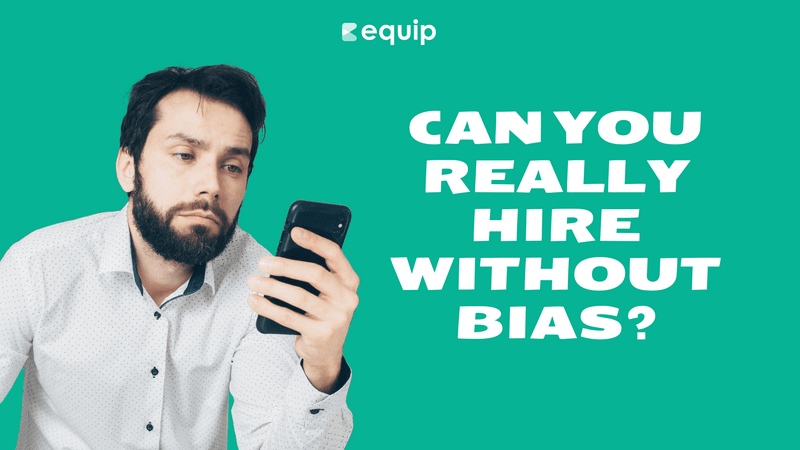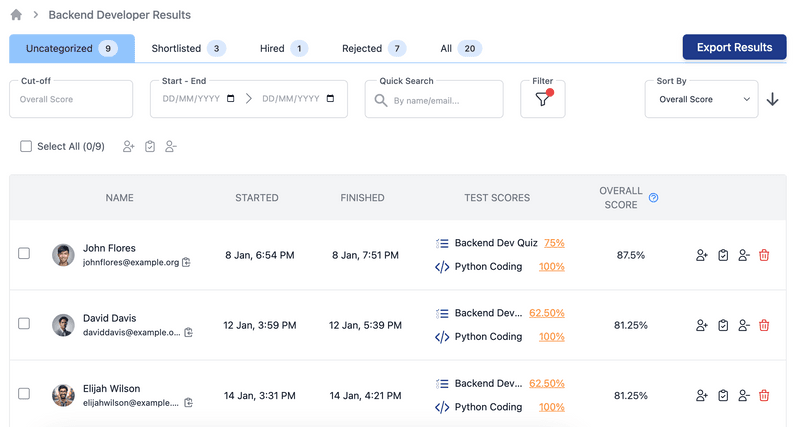
Recruitment professionals believe that hiring a team with diverse backgrounds and inclusive practices is important for success and performance. But bias in hiring can get in the way of that, causing big problems and limiting the potential of any business, no matter its size.
Imagine a situation where a skilled project manager is overlooked because the hiring team prefers candidates who attended the same university as they did. Or a talented tech specialist being automatically referred to as a “he” because the hiring manager believes the best candidate should be male. This kind of bias not only causes missed opportunities but can also bring about legal issues and harm the company's reputation.
You probably read about the case involving an ex-Amazon manager who was told by her supervisor to stalk job applicants on social media to determine their race and gender. This led not only to allegations of unethical hiring standards but also undermined trust in the company, potentially deterring diverse talent and leading to costly legal repercussions.
Reducing bias, conscious and unconscious, in hiring requires understanding how biases work and manifest in different stages of the recruitment process. This article aims to provide practical strategies to reduce bias in hiring and help organizations establish a fair recruitment process.
Understanding Bias in Hiring
Bias in hiring refers to the unfair preference for or prejudice against certain candidates based on personal characteristics rather than their qualifications or job performance.
This bias often manifests unconsciously, making it even more challenging to address.
Types of Biases:
- Unconscious Bias: This occurs when people make decisions influenced by stereotypes or prejudices they are unaware of. For example, a recruiter might unknowingly favor candidates who share similar interests or backgrounds.
- Confirmation Bias: This is when recruiters look for information that confirms their pre-existing beliefs or assumptions about a candidate. For example, if a recruiter believes that a particular university produces the best candidates, they might overlook flaws in a candidate's application simply because of their educational background.
- Affinity Bias: This bias leads recruiters to favor candidates who they perceive as similar to themselves. For instance, a hiring manager might prefer candidates from their alma mater, believing they will have a similar work ethic or values.
- Halo Effect: This occurs when a single positive attribute of a candidate influences the overall perception of them. For example, if a candidate has excellent communication skills, a recruiter might overlook other areas where the candidate is less competent.
The positive impact of reducing bias on workplace diversity, innovation, and overall company performance is well-documented. A homogenous team may lack the diverse perspectives needed to drive innovation and problem-solving. Moreover, biased hiring practices can damage a company's reputation, making it less attractive to top talent.
Strategies for Reducing Bias
There are ways companies can ensure they are evaluating candidates based on their skills and qualifications rather than personal characteristics. Let us take a look at some practical steps to help reduce bias in your hiring process and build a more diverse team.
Structured Interviews
- Structured interviews involve asking all candidates the same set of predetermined questions, ensuring a fair and consistent evaluation process. This method reduces the influence of unconscious bias and focuses on the candidate's skills and qualifications.
- How to implement: Develop a list of standardized questions relevant to the job role. Train interviewers to follow this structure and use a consistent scoring system to evaluate responses. Or use an ATS for collaborating with the interview panel with standardized questions and clear interview guides.
Blind Recruitment
- Blind recruitment involves removing personal information (such as names, gender, photos and age) from applications to prevent bias. This approach ensures that candidates are assessed solely based on their skills and experience.
- How to implement: Use HR software tools to anonymize applications. Focus on evaluating candidates' work samples, skills tests, and experience without considering personal identifiers.
You can try using these tools to implement a blind hiring process:
1. Applied: Anonymizes candidate applications by removing identifying information like names, photos, and contact details.
2. Blendoor: Hides candidates' personal information during resume review to reduce bias.
3. Textio: Optimizes job descriptions to be free of biased language, attracting a diverse range of applicants.
4. TalVista (formerly Talent Sonar): Creates structured interview processes and removes personal details from candidate applications.
5. Pinpoint: Anonymizes candidate data during the application review process and provides diversity analytics.
Standardized Assessments
- Standardized assessments evaluate candidates' aptitude and skills through objective tests. This method provides a fair comparison between candidates and reduces the impact of subjective judgment.
- How to implement: Develop or utilize existing standardized tests that are relevant to the job role. Ensure the assessments are administered and scored consistently for all candidates. Equip exactly does that for you.
Diverse Hiring Panels
- Diverse hiring panels consist of interviewers with unique skills set and from different backgrounds, genders, and ethnicities. This diversity helps mitigate individual biases and ensures a more balanced evaluation of candidates.
- How to implement: Assemble hiring panels with diverse members from various departments and levels within the organization. Provide training to panel members on recognizing and addressing bias.
Bias Training
- Bias training educates recruiters and hiring managers about the different types of biases and how to counteract them. This training can also include microaggressions—subtle, often unintentional comments or behaviors that can communicate negative stereotypes or assumptions about a candidate.
- How to implement: Develop or source comprehensive bias training programs. Include modules on unconscious bias, microaggressions, and strategies for fair evaluation. Conduct regular refresher courses to ensure ongoing awareness.
Debunking Common Biases in Hiring
Many misconceptions about hiring practices can inadvertently perpetuate bias. By understanding and challenging these myths, organizations can make more informed and fair decisions. Let’s take a look at some common hiring biases and set the record straight with the facts.
Myth #1: Résumés with prestigious universities or companies automatically indicate a better candidate.
Fact: While these experiences can be valuable, a candidate's skills and fit for the specific role should be the priority. Look for transferable skills and assess a candidate's potential for growth.
Myth #2: A likable personality is the most important factor in a candidate.
Fact: Likability can be subjective and influenced by bias. However, you can use psychometric tests to measure various psychological skills and traits to assess an individual’s capabilities, personality, and behaviors.
Myth #3: Hiring quotas are unfair and lead to hiring less qualified candidates.
Fact: Quotas can be a helpful tool to ensure a diverse pool of candidates is considered, but the final decision should always be based on merit.
Myth #4: Gaps in employment history are a red flag.
Fact: Gaps can occur for various reasons like parental leave, caregiving, or travel. Focus on understanding the reasons behind the gap and how the candidate's skills remained relevant during that time.
Myth #5: Experience in a similar role is essential.
Fact: The ability to learn and adapt is crucial. Consider candidates with transferable skills and a strong willingness to learn the specifics of the role.
How Equip Can Help in Reducing Bias in Hiring
Equip offers several features that help reduce bias in hiring by focusing on candidates' skills rather than personal characteristics. Here's how:
- Creating and Sharing Assessments: Use Equip's Question Banks or create custom tests tailored to the specific skills required for the job. Share these assessments with candidates through a secure link.
Explore Skills on Equip - Analyzing Candidate Performance: Equip automatically scores candidates' responses, providing objective data on their performance. This eliminates the influence of subjective judgment in the initial screening process.
- Shortlisting Top Performers: Based on the assessment results, shortlist the top-performing candidates who have demonstrated the necessary skills and abilities for the role.

Do you think you can eliminate bias from recruitment?
Humans tend to be biased because our brains use shortcuts, called heuristics, to make quick decisions, which can lead to unfair judgments. We're also influenced by social and cultural factors, which reinforce stereotypes and preconceptions from a young age. On top of that, our personal experiences and emotions can skew our perceptions, making it tough to stay completely objective.
Yet, reducing bias in the hiring process is essential for building a team where everyone feels included.By implementing these strategies, addressing common myths about hiring, and leveraging tools like Equip, companies can make fairer and more objective hiring choices. This doesn't just lead to better hires—it also brings lasting cultural benefits, creating a welcoming environment where everyone can thrive.
Explore Equip’s most useful features that help you achieve unbiased hiring and build a stronger, more diverse team.